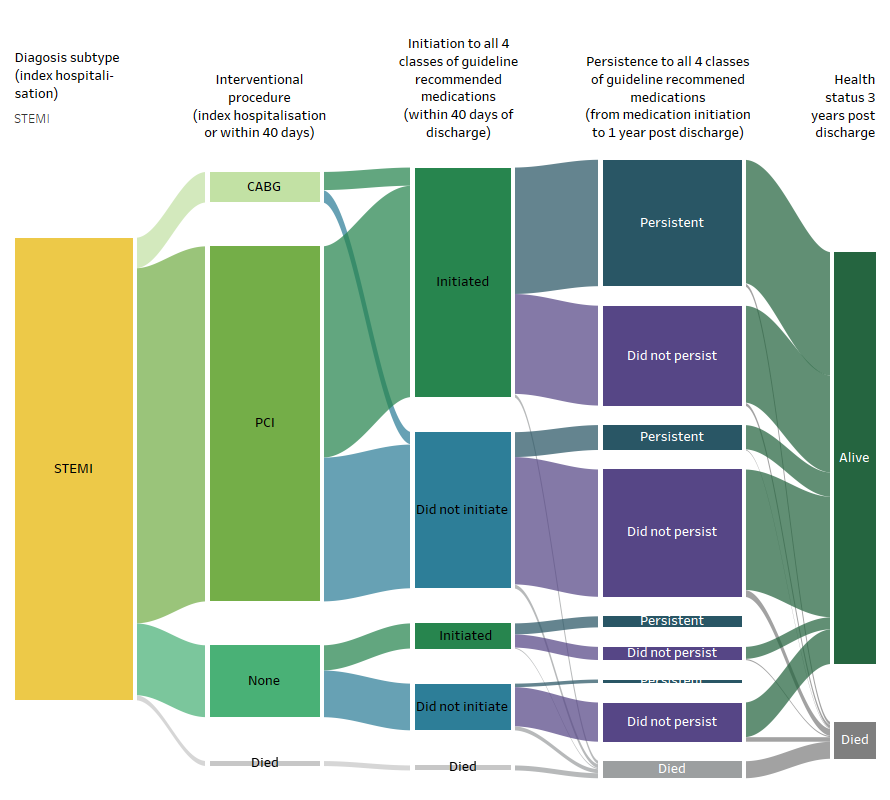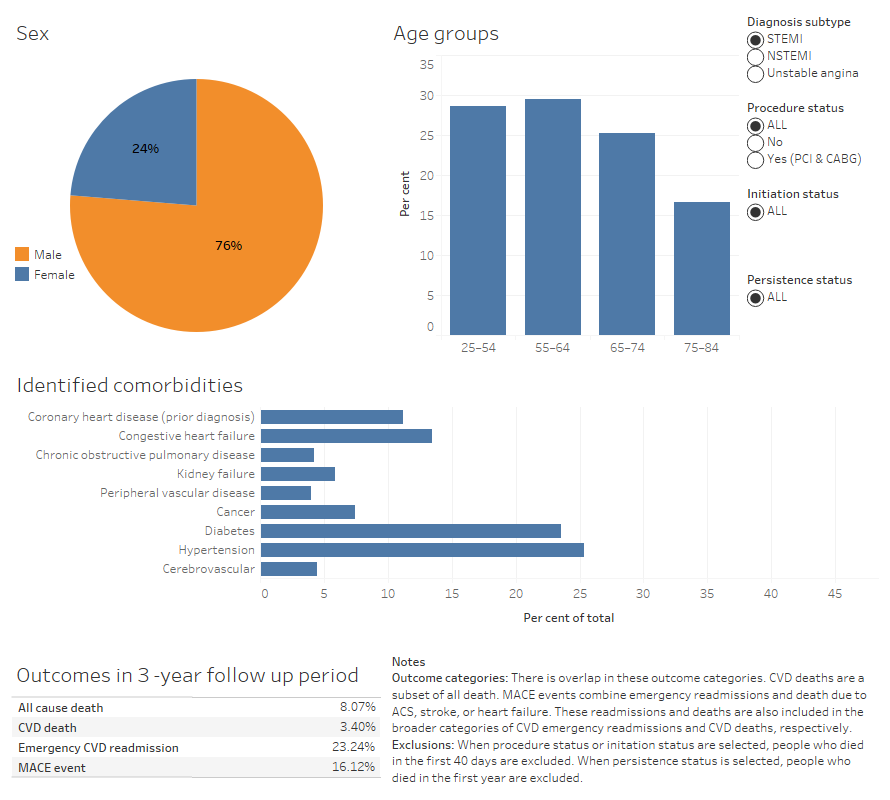ST-segment elevation myocardial infarction (STEMI)
ST-segment elevation myocardial infarction (STEMI) is a type of heart attack almost always caused by a complete blockage to a major coronary artery. This is the most easily diagnosed subtype of acute coronary syndrome (ACS) and accounted for 22% of the cohort.
- Individuals with STEMI had the highest rate of interventional procedure (84%) of the diagnosis groups.
- Those who had no procedure were more often women, had a history of coronary heart disease (CHD), and lived in Outer regional, Remote and Very remote areas compared to those who underwent an interventional procedure (PCI or CABG).
- STEMI was the only diagnosis group for which the most comprehensive treatment pathway (an interventional procedure, initiation and persistence to all 4 classes of guideline recommended medications) was one of the most common, taken by 27%. For those with a STEMI diagnosis, adverse health outcomes were lowest among those who took this treatment pathway.
- CVD emergency readmissions were 19% compared with 24% for the other treatment pathways combined. Major cardiac events (MACE) 12% compared to 17%.
- This group had a lower proportion people aged 75 to 84 years, lower prior CHD and comorbidities identified compared to the other treatment pathways combined.
Explore the treatment pathways for the people with this diagnosis in Figure 4 and information about the people who followed these pathways in Figure 5.
A summary of these treatment pathways and the people who followed them is below.
Figure 4: Treatment pathways and outcomes, among those with STEMI
This Sankey shows the proportion of people who followed different treatment pathways illustrated with the 3 measurement points and survival at 3 years.

Source: AIHW NIHSI 2016-17 to 2019-20, analysis of NIHSI
Figure 5: Age group, sex, identified comorbidities, and health outcomes among those with STEMI, by treatment pathway group
Figuresshow that among those with STEMI, the most common age group is 55-64 andcomorbidity is hypertension.

Source: AIHW NIHSI 2010-11 to 2019-20, analysis of NIHSI
People’s treatment pathways after a STEMI hospitalisation
People’s treatment pathways are described using 3 measurement points during or after their initial ACS hospitalisations (referred to as the index hospitalisation).
Note that differences in health outcomes experienced by people following different treatment pathways should not be interpreted as causal. Many factors, impact both treatment decisions and the risk of experiencing poor health outcomes.
Measurement point 1: Interventional procedures
During their index hospitalisation (or within 40 day), 84% of people with STEMI had an interventional procedure. Around 4 in 5 people (78%) with STEMI underwent a PCI. Of these individuals, around 1 in 5 (22%) were women, and 11% lived in Outer regional, Remote and Very remote areas. One in 10 had a prior CHD diagnosis. Twenty-two percent had an emergency CVD readmission in the follow up period, and 5% died.
Seven percent of people with STEMI underwent a CABG procedure at the index hospitalisation or in the 40 days post discharge. Of these individuals, 18% were women, 15% lived in Outer regional, Remote and Very remote areas, and 10% had a history of CHD. Twenty two percent had an emergency CVD readmission during the follow up period, and 6.6% died.
Among those with STEMI who did not undergo a procedure (16%), 1 in 3 were women, and 18% lived in Outer regional, Remote and Very remote areas. History of CHD was more common among those who had no procedure (30%) when compared to those who underwent PCI or CABG. Thirty-one percent had an emergency CVD readmission, and 16% died in the follow-up period.
Measurement point 2: Medication initiation
Initiation to all guideline-indicated medications was higher among those who underwent a procedure in people with STEMI. Of people with STEMI, 35% of those who did not undergo a procedure, and 60% of those who underwent a PCI and/or a CABG procedure, initiated guideline indicated medications within 40 days. A slightly higher proportion of men initiated the 4 medicine classes compared with women (57% and 51% respectively).
Emergency CVD readmissions and all cause death was highest among those who did not undergo a procedure or initiate medicines within 40 days (30% and 19% respectively), and lowest among those who underwent a procedure and initiated all classes of guideline Indicated medications (22% and 4% respectively).
Measurement point 3: Persistence to medication
Note, persistence measures are only estimated for those who were alive at one year. All comparisons below exclude people who died in the first year after index hospitalisation.
For individuals with STEMI who were alive at one year, emergency CVD readmissions, a MACE, and all-cause death were lowest among those who underwent an interventional procedure, initiated 4 classes of medicines in 40 days and were persistent at 1 year (CVD readmissions: 18% MACE: 12% All cause death: 2.4%).
Emergency readmissions and MACE were highest among those who did not undergo a procedure, initiated medications at 40 days but were non-persistent at 1 year post discharge (32% and 25% for CVD readmissions and MACE respectively).
The rate of death (after the first year) from any cause was highest among those who did not undergo a procedure, initiate guideline recommended medications or persist at 1 year (19%). This group were older than other STEMI treatment subgroups, which would be a likely influence on both treatment decisions and the higher rate of death in this group. Age has been shown to be an independent predictor of adverse health outcomes in high-risk MI patients. (Nedkoff 2023)
See Figure 5 for comparisons of age group, sex, comorbidities and health outcomes among treatment groups.


